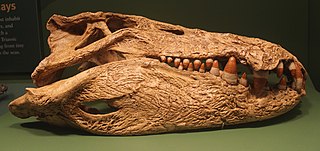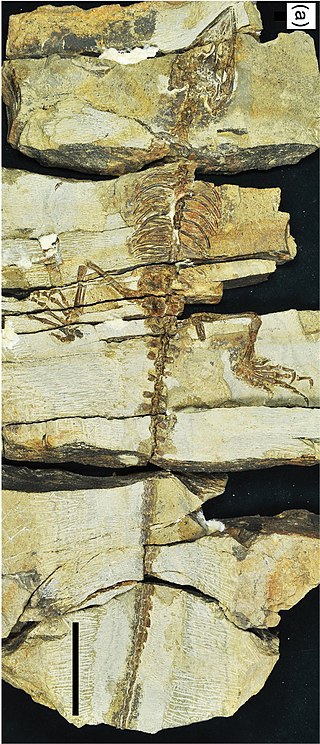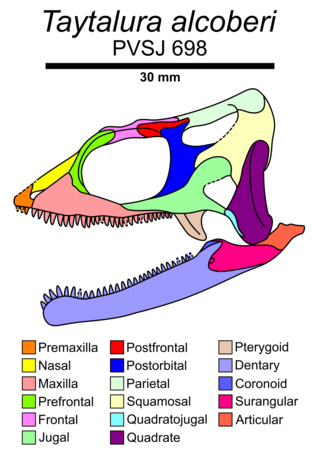
Rhynchocephalia is an order of lizard-like reptiles that includes only one living species, the tuatara of New Zealand. Despite its current lack of diversity, during the Mesozoic rhynchocephalians were a speciose group with high morphological and ecological diversity. The oldest record of the group is dated to the Middle Triassic around 238 to 240 million years ago, and they had achieved a worldwide distribution by the Early Jurassic. Most rhynchocephalians belong to the group Sphenodontia ('wedge-teeth'). Their closest living relatives are lizards and snakes in the order Squamata, with the two orders being grouped together in the superorder Lepidosauria.

Askeptosaurus is an extinct genus of askeptosauroid, a marine reptile from the extinct order Thalattosauria. Askeptosaurus is known from several well-preserved fossils found in Middle Triassic marine strata in what is now Italy and Switzerland.

Tasmaniosaurus is an extinct genus of archosauromorph reptile known from the Knocklofty Formation of West Hobart, Tasmania, Australia. The type species is T. triassicus. This genus is notable not only due to being one of the most complete Australian Triassic reptiles known, but also due to being a very close relative of Archosauriformes. Once believed to be a proterosuchid, this taxon is now believed to have been intermediate between advanced non-archosauriform archosauromorphs such as Prolacerta, and basal archosauriforms such as Proterosuchus. Features traditionally used to define Archosauria and later Archosauriformes, such as the presence of an antorbital fenestra and serrated teeth, are now known to have evolved prior to those groups due to their presence in Tasmaniosaurus.

Mahajangasuchus is an extinct genus of crocodyliform which had blunt, conical teeth. The type species, M. insignis, lived during the Late Cretaceous; its fossils have been found in the Maevarano Formation in northern Madagascar. It was a fairly large predator, measuring up to 4 metres (13 ft) long.
Rautiania is an extinct genus of gliding neodiapsid reptiles belonging to the family Weigeltisauridae. Isolated fossil remains of Rautiania are known from the Late Permian of Russia. The genus is known from two species, Rautiania alexandri and Rautiania minichi, which differ in aspects of their maxilla and parietal bones. Certain Rautiania fossils have helped to reveal certain aspects of weigeltisaurid anatomy and lifestyle which had long alluded paleontologists, such as the component bones of the "crest" at the back of the head, and the large amount of adaptations towards life in the canopies of forests.

Qianosuchus is an extinct genus of aquatic poposauroid archosaur from the middle Triassic (Anisian) Guanling Formation of Pan County, China. It is represented by two nearly complete skeletons and a crushed skull preserved in the limestone. Qianosuchus was at least 3 metres long, and had several skeletal adaptations which indicate a semi-marine lifestyle, similar to modern-day saltwater crocodiles. These adaptations have not been seen in any other archosaur from the Triassic.

Acerosodontosaurus is an extinct genus of neodiapsid reptiles that lived during the Upper Permian of Madagascar. The only species of Acerosodontosaurus, A. piveteaui, is known from a natural mold of a single partial skeleton including a crushed skull and part of the body and limbs. The fossil was discovered in deposits of the Lower Sakamena Formation. Based on skeletal characteristics, it has been suggested that Acerosodontosaurus individuals were at least partially aquatic.

Vancleavea is a genus of extinct, armoured, non-archosaurian archosauriforms from the Late Triassic of western North America. The type and only known species is V. campi, named by Robert Long & Phillip A Murry in 1995. At that time, the genus was only known from fragmentary bones including osteoderms and vertebrae. However, since then many more fossils have been found, including a pair of nearly complete skeletons discovered in 2002. These finds have shown that members of the genus were bizarre semiaquatic reptiles. Vancleavea individuals had short snouts with large, fang-like teeth, and long bodies with small limbs. They were completely covered with bony plates known as osteoderms, which came in several different varieties distributed around the body. Phylogenetic analyses by professional paleontologists have shown that Vancleavea was an archosauriform, part of the lineage of reptiles that would lead to archosaurs such as dinosaurs and crocodilians. Vancleavea lacks certain traits which are present in most other archosauriforms, most notably the antorbital, mandibular and supratemporal fenestrae, which are weight-saving holes in the skulls of other taxa. However, other features clearly support its archosauriform identity, including a lack of intercentra, the presence of osteoderms, an ossified laterosphenoid, and several adaptations of the femur and ankle bones. In 2016, a new genus of archosauriform, Litorosuchus, was described. This genus resembled both Vancleavea and more typical archosauriforms in different respects, allowing Litorosuchus to act as a transitional fossil linking Vancleavea to less aberrant archosauriforms.
Australothyris is an extinct genus of basal procolophonomorph parareptile known from the Middle Permian of Tapinocephalus Assemblage Zone, South Africa. The type and only known species is Australothyris smithi. As the most basal member of Procolophonomorpha, Australothyris helped to contextualize the origin of this major parareptile subgroup. It has been used to support the hypotheses that procolophonomorphs originated in Gondwana and ancestrally possess temporal fenestrae, due to its large and fully enclosed temporal fenestra and South African heritage. It also possessed several unique features, including a high tooth number, long postfrontal, small interpterygoid vacuity, and a specialized interaction between the stapes and quadrate.

Fodonyx is an extinct genus of rhynchosaur from the middle Triassic epoch of Devon in England. Its fossils were discovered in Otter Sandstone Formation and were first assigned to Rhynchosaurus spenceri. This species was reassigned to its own genus, Fodonyx the holotype of which is EXEMS 60/1985/292, that described by David W. E. Hone and Michael J. Benton in 2008. More recently, one skull was reassigned to the new genus Bentonyx. It is distinguished from other rhynchosaurs by a single autapomorphy, the ventral angling of the paraoccipital processes. In all other rhynchosaurs these processes angle dorsally or are horizontal. It is not known if this conferred any advantage to Fodonyx. Fodonyx was between 40 and 50 cm long.

Rhadinosuchus is an extinct genus of proterochampsian archosauriform reptile from the Late Triassic. It is known only from the type species Rhadinosuchus gracilis, reposited in Munich, Germany. The fossil includes an incomplete skull and fragments of post-cranial material. Hosffstetter (1955), Kuhn (1966), Reig (1970) and Bonaparte (1971) hypothesized it to be synonymous with Cerritosaurus, but other characteristics suggest it is closer to Chanaresuchus and Gualosuchus, while it is certainly different from Proterochampsa and Barberenachampsa. The small size indicates it is a young animal, making it hard to classify.
Dianopachysaurus is an extinct genus of pachypleurosaur known from the lower Middle Triassic of Yunnan Province, southwestern China. It was found in the Middle Triassic Lagerstätte of the Guanling Formation. It was first named by Jun Liu, Olivier Rieppel, Da-Yong Jiang, Jonathan C. Aitchison, Ryosuke Motani, Qi-Yue Zhang, Chang-Yong Zhou and Yuan-Yuan Sun in 2011 and the type species is Dianopachysaurus dingi, thanking a Professor Ding for his help.

Jesairosaurus is an extinct genus of early archosauromorph reptile known from the Illizi Province of Algeria. It is known from a single species, Jesairosaurus lehmani. Although a potential relative of the long-necked tanystropheids, this lightly-built reptile could instead be characterized by its relatively short neck as well as various skull features.
Jaxtasuchus is an extinct genus of armored doswelliid archosauriform reptile known from the Middle Triassic of the Erfurt Formation in Germany. The type species, Jaxtasuchus salomoni, was named in 2013 on the basis of several incomplete skeletons and other isolated remains. Like other doswelliids, members of the genus were heavily armored, with four longitudinal rows of bony plates called osteoderms covering the body. Jaxtasuchus is the first doswelliid known from Europe and is most closely related to Doswellia from the Late Triassic of the eastern United States. However, it was not as specialized as Doswellia, retaining several generalized archosauriform characteristics and having less armor. Jaxtasuchus fossils have been found in aquatic mudstones alongside fossils of temnospondyl amphibians, crustaceans, and mollusks, suggesting that Jaxtasuchus was semiaquatic like modern crocodilians.
This glossary explains technical terms commonly employed in the description of dinosaur body fossils. Besides dinosaur-specific terms, it covers terms with wider usage, when these are of central importance in the study of dinosaurs or when their discussion in the context of dinosaurs is beneficial. The glossary does not cover ichnological and bone histological terms, nor does it cover measurements.

Caihong is a genus of small paravian theropod dinosaur from China that lived during the Late Jurassic period.

Sapheosaurs are an extinct group of rhynchocephalian reptiles from the Late Jurassic period. "Sapheosaurs" is an informal name for a group of rhynchocephalians closely related to the genus Sapheosaurus. It was first recognized as a group containing multiple genera by Hoffstetter in 1955. The group has sometimes been given a formal taxonomic name as the family Sapheosauridae, although in some analyses this group belongs to the family Sphenodontidae and thus cannot be assigned its own family. They were fairly advanced rhynchocephalians which may have had semiaquatic habits.

Coeruleodraco is an extinct genus of choristoderan known from the Late Jurassic (Oxfordian) Tiaojishan Formation in China. Coeruleodraco is significant as the most complete Jurassic choristodere taxon, as the only other named Jurassic choristodere Cteniogenys is based on fragmentary remains. Although similar to Philydrosaurus in its proportions and postcranial characters, it is distinct in retaining several apparently plesiomorphic characters, including a short snout, paired external nares and an open lower temporal fenestra.
Gunakadeit is an extinct genus of thalattosaur. It is known from a single species, Gunakadeit joseeae, which is based on an articulated and mostly complete skeleton from the late Triassic Hound Island Volcanics of Alaska. Gunakadeit possessed a variety of features from the two major suborders of thalattosaurs, Askeptosauroidea and Thalattosauroidea, and it is considered the most basal member of the latter group. Despite this, it is also the youngest known thalattosaur genus, with the group going extinct at the end of the Triassic. Gunakadeit's basal position and relatively recent occurrence implies a 20-million-year ghost lineage connecting it to the rest of Thalattosauria. The skull ends in a sharply pointed and toothless tip like the askeptosauroid Endennasaurus, but unlike Endennasaurus, Gunakadeit had poorly developed joints and was likely exclusively aquatic in behavior.

Taytalura is an extinct genus of lepidosauromorph reptile from the Late Triassic of Argentina. It contains a single species, Taytalura alcoberi, which is based on a well-preserved skull from the fossiliferous Ischigualasto Formation. As a lepidosauromorph, Taytalura is a distant relative of modern lepidosaurs such as sphenodontians and squamates. Taytalura did not belong to any group of modern lepidosaurs, since it bears unique features, such as unfused bones in the skull roof and teeth which all sit loosely in a deep groove without sockets. Regardless, Micro-CT scanning reveals features of the skull previously only seen in rhynchocephalians. This suggests that the ancestral condition of the skull in lepidosaurs was more similar to sphenodonts than to squamates.
















